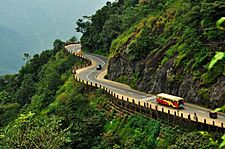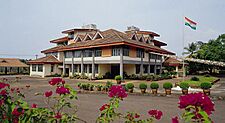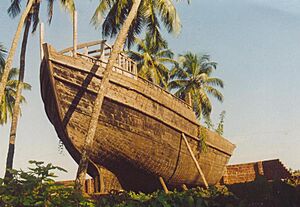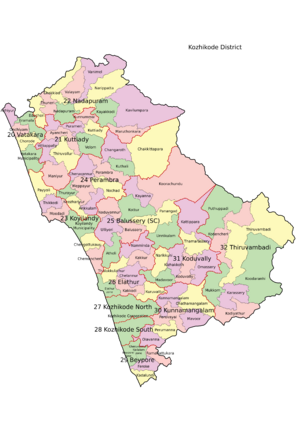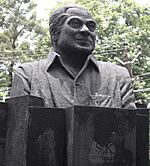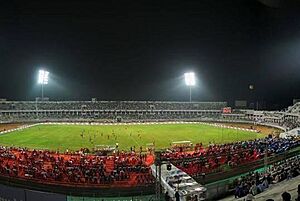Kozhikode district facts for kids
Quick facts for kids
Kozhikode district
|
|
|---|---|
|
Clockwise from top:
Kozhikode Beach, KSRTC bus stand complex, Hilite Mall, Chaliyam harbour, Administrative block of NIT Calicut, IIM Kozhikode, Calicut Mini Bypass, and Thamarassery Churam. |
|
| Country | |
| State | Kerala |
| Headquarters | Kozhikode |
| Area | |
| • Total | 2,344 km2 (905 sq mi) |
| Area rank | 9th |
| Highest elevation
(Vavul Mala)
|
2,339 m (7,674 ft) |
| Population
(2018)
|
|
| • Total | 3,249,761 |
| • Density | 1,386/km2 (3,590/sq mi) |
| Languages | |
| • Official | Malayalam, English |
| Time zone | UTC+5:30 (IST) |
| ISO 3166 code | IN-KL |
| Vehicle registration | KL-11 Calicut City, KL-18 Vatakara, KL-56 Koyilandy, KL-57 Koduvally, KL-76 Nanmanda, KL-77 Perambra, KL-85 Ramanattukara (Feroke) |
| HDI (2005) | |
Kozhikode (pronounced [koːɻikːoːɖɨ̆]) is a district in the Indian state of Kerala. It is located along the southwestern Malabar Coast. The main city, also called Calicut, is the district's capital. Most of the district (about 67%) is urban.
The city of Kozhikode is very large. Its metropolitan area has over 2 million people. This makes it the second-largest in Kerala. It is also the 19th largest in India. The Indian government calls Kozhikode a "Tier 2 city." Important national schools like NIT Calicut and IIM Kozhikode are in this district.
Kozhikode was the biggest city in the old Malabar District. It was its main center during the British Raj. In ancient times, Kozhikode was known as the City of Spices. It was a major trading spot for Indian spices. It was also the capital of a kingdom ruled by the Samoothiris (Zamorins). This was the largest kingdom in Kerala before the 1700s. The port of Kozhikode was a gateway for traders from China, Arabia, Portugal, the Netherlands, and Britain.
Kozhikode district shares borders with Kannur and Mahé (from Puducherry) to the north. To the east is Wayanad. To the south is Malappuram. The Arabian Sea is to the west. The Western Ghats mountains are to the east. Vavul Mala is the highest point in the district. It is a 2,339-meter (7,674 ft) high peak. It sits where Kozhikode, Malappuram, and Wayanad districts meet. The Thamarassery Churam is a mountain pass. It connects Kozhikode city to the Wayanad plateau.
The district is split into four main areas called taluks. These are Kozhikode, Vatakara, Koyilandy, and Thamarassery. In 2011, there were 12 block panchayats. A report in 2015–16 said Kozhikode was the third-least poor district in India. It had a very low poverty rate of 0.26%.
Contents
What's in a Name? The Origin of Kozhikode
The exact start of the name Kozhikode is not fully known. Many people think it comes from Koyil-kota. This means "fortified palace." Koil or Koyil is a Malayalam/Tamil word for a Hindu temple. It might refer to the Tali Shiva Temple.
Arab traders called the city Qāliqūṭ. Chinese traders called it Kūlifo. People from Tamil Nadu called it Kallikottai. The city's official name in Malayalam is Kozhikode. In English, it is known as Calicut.
The word calico comes from Calicut. Calico is a fine cotton cloth that was shipped from Kozhikode's port. Even calico cats, known for their three colors, get their name from this fabric.
A Look at Kozhikode's Past
After Kerala was formed in 1956, the old Malabar District was divided. It became three new districts: Kannur district, Kozhikode district, and Palakkad district.
At that time, Kozhikode district had two main areas. These were Kozhikode Revenue Division and Malappuram Revenue Division. Kozhikode Revenue Division had four taluks. They were Vatakara, Koyilandy, Kozhikode, and South Wayanad. Malappuram Division had two taluks: Eranad and Tirur.
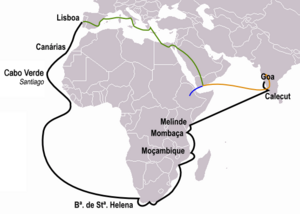
On June 16, 1969, the Malappuram Revenue Division was separated. It formed the Malappuram district. Three villages (Feroke, Ramanattukara, and Kadalundi) stayed with Kozhikode.
Later, on November 1, 1980, the South Wayanad Taluk was also separated. It became the Wayanad district.
Kozhikode's People: Demographics
Kozhikode district had a population of 3,249,761 in 2018. This is about the same as the country of Mongolia. In 2011, it was the 115th most populated district in India. Its population grew by 7.31% between 2001 and 2011.
Kozhikode has more females than males. There are 1097 females for every 1000 males. The district also has a high literacy rate of 95.24%. Most people (67.15%) live in cities and towns.
The Kozhikode metropolitan area has over 2 million people. This makes it the second-largest in Kerala. It is also the 19th largest in India.
A report from 2015–16 found Kozhikode to be one of the least poor districts in India. Only Kottayam and Ernakulam had lower poverty rates.
Malayalam is the main language spoken here. About 99.05% of the people speak it. Small groups of people speak Tamil and Hindi. This is mostly in the cities.
Many years of trade across the Indian Ocean have made Kozhikode a diverse place. People from many different backgrounds live here.
Religion in Kozhikode
Religions in Kozhikode district (2011) Hinduism (56.21%) Islam (39.24%) Christianity (4.26%) Other or not stated (0.29%%)
According to the 2011 census, most people in Kozhikode are Hindus. Muslims are the second-largest group, followed by Christians. In 2011, Hindus made up 56.21% of the population. Muslims were 39.24%, and Christians were 4.26%.
There are also small numbers of Jains, Sikhs, and Buddhists living in the district.
Kozhikode's Weather and Climate
The district usually has a humid climate. It has a very hot season from March to May. The rainy season is during the South West Monsoon. This starts in the first week of June and lasts until September. The North East Monsoon comes from October through November.
The average yearly rainfall is 3266 millimeters (128.6 inches). The best weather is in December and January. The skies are clear, and the air is fresh. The highest temperature ever recorded was 39.4°C (102.9°F) in March 1975. The lowest was 14°C (57°F) on December 26, 1975.
| Climate data for Kozhikode | |||||||||||||
|---|---|---|---|---|---|---|---|---|---|---|---|---|---|
| Month | Jan | Feb | Mar | Apr | May | Jun | Jul | Aug | Sep | Oct | Nov | Dec | Year |
| Mean daily maximum °C (°F) | 31.6 (88.9) |
32.0 (89.6) |
32.7 (90.9) |
33.1 (91.6) |
32.4 (90.3) |
29.4 (84.9) |
28.4 (83.1) |
28.3 (82.9) |
29.5 (85.1) |
30.6 (87.1) |
31.3 (88.3) |
31.6 (88.9) |
30.9 (87.6) |
| Mean daily minimum °C (°F) | 22 (72) |
23.4 (74.1) |
25 (77) |
26.1 (79.0) |
25.8 (78.4) |
24 (75) |
23.5 (74.3) |
23.5 (74.3) |
24 (75) |
24 (75) |
23.6 (74.5) |
22.7 (72.9) |
23.8 (74.8) |
| Average rainfall mm (inches) | 2.7 (0.11) |
3.4 (0.13) |
21.4 (0.84) |
90.2 (3.55) |
310.9 (12.24) |
818.2 (32.21) |
902.5 (35.53) |
447.3 (17.61) |
233.4 (9.19) |
263.5 (10.37) |
136.6 (5.38) |
35 (1.4) |
3,265.1 (128.56) |
How Kozhikode is Governed
The main office for the district government is the Kozhikode Civil Station. It is located in West Hill. The District collector leads the district government. Deputy collectors help the Collector. They handle things like land, money, and elections.
Cities and Towns in Kozhikode
Kozhikode district has seven municipal towns. It also has the Kozhikode Municipal Corporation. This corporation was set up in 1962. It was the second municipal corporation in Kerala.
Here are the municipal towns in Kozhikode district:
| Municipality | Population (2011) | Area(km2) | Population density (/km2) | Taluk |
|---|---|---|---|---|
| Vatakara | 75,295 | 21.32 | 3,532 | Vatakara |
| Koyilandy | 71,873 | 29.05 | 2,474 | Koyilandy |
| Feroke | 54,074 | 15.54 | 3,480 | Kozhikode |
| Payyoli | 49,470 | 22.34 | 2,214 | Koyilandy |
| Koduvally | 48,687 | 23.85 | 2,041 | Thamarassery |
| Mukkam | 40,670 | 31.20 | 1,304 | Kozhikode |
| Ramanattukara | 35,937 | 11.70 | 3,072 | Kozhikode |
Who Represents Kozhikode?
Kozhikode has three areas that send representatives to the Lok Sabha (India's Parliament). These are Vatakara, Kozhikode, and Wayanad.
There are also 13 seats in the Kerala Legislative Assembly (the state's parliament) from Kozhikode district.
Kozhikode's Economy
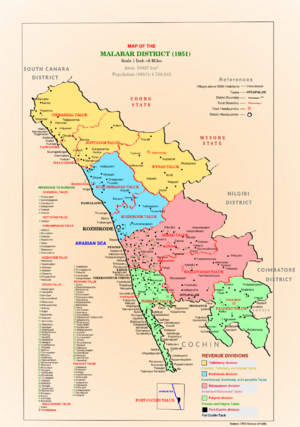
Kozhikode is one of the biggest economic centers in Kerala. About 8% of Kerala's people live here. The district makes more than 12% of the state's income.
Nedungadi Bank, the first and oldest bank in modern Kerala, started in Kozhikode in 1899. It was founded by Appu Nedungadi. Cyberpark in Kozhikode is an IT hub in Kerala. Kozhikode's economy relies a lot on its service sector.
Kozhikode's Rich Culture
Malayalam Language and Literature
Kozhikode district has given a lot to the Malayalam language and its literature. In the 17th century, King Samoothiri Manavedan Maharaja wrote Krishnattam. This famous text describes the childhood of Lord Krishna.
The district is known for its folk songs called Vadakkan Pattukal. These popular songs tell stories of heroes like Thacholi Othenan and Unniyarcha. A special debate for Vedic scholars happens at Thali temple. Winners get the title of Pattathanam.
Kozhikode is also linked to ghazals (a type of poetry/music) and football.
Many famous Malayalam writers come from Kozhikode. These include S. K. Pottekkatt, Thikkodiyan, and Punathil Kunjabdulla. S. K. Pottekkatt was a very celebrated writer. His award-winning book Oru Theruvinte Katha is set on S. M. Street in Kozhikode.
Several major Malayalam publishing houses are in the city. These include Poorna, Mathrubhumi, and Olive. Many libraries are also found here. The Kozhikode Public Library and Research Centre opened in 1996. In 2023, Kozhikode became India's first UNESCO City of Literature.
Music Scene in Kozhikode
Besides the Malabar Mahotsavam, Kozhikode's yearly cultural festival, there's a five-day music festival. It honors Tyagaraja and has been held every year since 1981. This festival includes traditional music and concerts by professional artists.
Kozhikode has a history of enjoying Ghazal and Hindustani music. Many Malayalam Ghazals exist. The late film director and singer M. S. Baburaj from Kozhikode was inspired by these music styles.
The city also hosts DJ parties and events in hotels, malls, and IT parks. Festivals at NITC and IIM feature international bands.
Delicious Food and Cuisine
Kozhikode offers many types of food. You can find South Indian, North Indian, European, Chinese, Arab, Gujarati, and Jain food. The city's food culture has been shaped by Portuguese, Dutch, French, British, Arab, and other Indian influences. It has a wide variety of both vegetarian and non-vegetarian dishes.
Fast food is very popular, and the city has a growing mall culture. Younger generations enjoy Chinese, Arab, and American food. Also, more people are choosing vegetarian food for health reasons.
The city is famous for Haluva. Europeans called it Sweet Meat because of its texture. Kozhikode has a main road called S. M. Street (Mittayi Theruvu). It got this name from the many Halwa shops there. This street's history goes back to the time of the Zamorin of Calicut. The ruler invited Gujarati sweet makers to set up shops near the palace.
Another special food is banana chips. They are made very thin and crispy. Other popular dishes include seafood like prawns, mussels, and mackerel. Vegetarian meals include the traditional sadya.
Kozhikode in Films
Kozhikode's film history began in the 1950s. Some major Malayalam film companies, like Grihalakshmi Productions, are based here. The city was also important for famous filmmakers like I. V. Sasi.
Kozhikode has produced many notable actors. These include K. P. Ummer, Mammukoya, and Santha Devi. Famous musician Baburaj, lyricist Gireesh Puthenchery, and filmmakers like Ranjith also come from Kozhikode.
The 1947 Hollywood movie Sinbad the Sailor mentions Kozhikode.
Kozhikode is the largest city in the Malabar region. It plays a key role in entertainment. The city's first movie theater, Calicut Crown, opened in 1925. Today, the city has over 10 theaters and two multiplexes. PVS Film City was the first multiplex in the Malabar region.
Sports in Kozhikode
Kozhikode is sometimes called the "second Mecca of football" (after Kolkata). Other popular sports here are cricket, basketball, badminton, and volleyball. The EMS Stadium has hosted many international football matches.
Many international footballers come from Kozhikode. One famous player was Olympian Abdurahman. He played for India in many international games, including the Melbourne Olympic games. The seven-a-side form of football is also very popular.
P. T. Usha is a famous athlete from Kozhikode. She is known as one of India's greatest athletes. People often call her the "queen of Indian track and field." Her nickname is Payyoli Express. She now runs the Usha School of Athletics in Koyilandy.
T. Abdul Rahman, known as Olympian Rahman, was an Indian Olympic footballer. He was part of the Indian team that reached the semi-final in the 1956 Melbourne Olympics.
Other sports stars include Jimmy George and Tom Joseph (a volleyball player).
Jaseel P. Ismail, V. Diju, Aparna Balan, and Arun Vishnu are international badminton players from the city.
The Sports & Education Promotion Trust (SEPT) works to promote sports in India. It focuses on football. Started in 2004, it has set up 52 "football nurseries" across Kerala. Since 2010, the Calicut Mini Marathon has been organized by IIM Kozhikode. About 7000 people join it every year.
News and Media

Kozhikode is important in the history of Malayalam journalism. The first newspaper in the district might have been Kerala Pathrika in 1880.
Kozhikode is where widely read Malayalam newspapers like Mathrubhumi, Desabhimani, and Madhyamam began. Other daily newspapers published here include Chandrika and Thejas. Many other major newspapers from outside the state also have offices in Kozhikode. The Times of India, a large English newspaper, started printing in Kozhikode in 2012. Many weekly, fortnightly, and monthly magazines are also published here.
Radio and Television
The Kozhikode radio station of All India Radio has two transmitters. One is Kozhikode AM (100 kilowatt) and the other is Kozhikode FM (10 kilowatt). Private FM radio stations include Radio Mango 91.9 and Red FM 93.5.
A television transmitter has been working in Kozhikode since 1984. It relays programs from Delhi and Thiruvananthapuram Doordarshan. Doordarshan has its broadcasting center at Medical College. Malayalam channels based in Kozhikode include Shalom Television and Media One TV. All major Malayalam channels have studios and news offices in the city.
Satellite TV services are available through various providers. Asianet Cable Vision (ACV) broadcasts daily city news.
The Calicut Press Club started in 1970. It is a central place for all media activities. It began with about 70 members and now has over 280.
Getting Around Kozhikode: Transport
Air Travel

Kozhikode is served by Calicut International Airport (CCJ/VOCL). It is located in Karipur in Malappuram District. The airport is about 28 kilometers (17 miles) from Kozhikode city. It started operating in April 1988. It has two terminals: one for domestic flights and one for international flights.
Road Travel
Kozhikode has good road connections. National Highways 66 and 766 connect Calicut to the rest of India. There are bus services to all parts of Kerala, Karnataka, and Tamil Nadu. Buses also go to important cities like Hyderabad and Mumbai. A new national highway is planned from Calicut to Bangalore.
Famous People from Kozhikode
- Literature
- S. K. Pottekkatt
- Thikkodiyan
- Punathil Kunjabdulla
- U. A. Khader
- Akbar Kakkattil
- N. N. Kakkad
- P. Valsala
- M. N. Karassery
- M. T. Vasudevan Nair
- Music
- M. S. Baburaj
- Baburaj
- Gireesh Puthenchery
- Film
- I. V. Sasi
- T. Damodaran
- Ummer
- Mammukoya
- Balan K. Nair
- Santha Devi
- Parvathy Thiruvothu
- Kuthiravattam Pappu
- Ranjith
- V. M. Vinu
- A. Vincent
- Shajoon Kariyal
- Anjali Menon
- P. S. Nivas
- Neeraj Madhav
- Madhupal
- Anoop Menon
- Nellikode Bhaskaran
- Augustine
- Surabhi Lakshmi
- Sports
- T. Abdul Rahman
- P. T. Usha
- Jaseel P. Ismail
- V. Diju
- Aparna Balan
- Arun Vishnu
- Tom Joseph
- Roy Joseph
- Mayookha Johny
- Prasanth Karuthadathkuni
- Jinson Johnson
- Kishor Kumar
- Rehenesh TP
- Muhammed Nemil
- Gani Nigam
- Leon Augustine
- Others
- Ali Manikfan
- M. P. Ahammed
Images for kids
See also
 In Spanish: Distrito de Kozhikode para niños
In Spanish: Distrito de Kozhikode para niños



